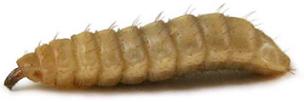 The little guy on the left might not look very pretty, but it could be beautiful when it comes to turning food waste into biodiesel. It’s the larva of the Black Soldier Fly, and this bug is at the heart of EcoSystem Corporation’s MAGFUEL™ biofuel feedstock model.
The little guy on the left might not look very pretty, but it could be beautiful when it comes to turning food waste into biodiesel. It’s the larva of the Black Soldier Fly, and this bug is at the heart of EcoSystem Corporation’s MAGFUEL™ biofuel feedstock model.
This company press release says EcoSystem is using the larvae to turn food scrap waste into natural oils for biodiesel feedstock:
 When at full capacity, Black Soldier Fly food scrap waste conversion technology could yield up to 190,000 gallons of crude (non-food) natural oils per acre of bioreactor surface area annually. In comparison, soybean yields an average of 40 gallons of oil per acre annually. EcoSystem’s integrated bioreactor is estimated to be deployed at a cost of less than $100 per square foot with minimal use of utilities for other than periodic cleaning and heating.
When at full capacity, Black Soldier Fly food scrap waste conversion technology could yield up to 190,000 gallons of crude (non-food) natural oils per acre of bioreactor surface area annually. In comparison, soybean yields an average of 40 gallons of oil per acre annually. EcoSystem’s integrated bioreactor is estimated to be deployed at a cost of less than $100 per square foot with minimal use of utilities for other than periodic cleaning and heating.
According to the Environmental Protection Agency (EPA), the annual food scrap waste generated per capita in the U.S. is 1,678 pounds, of which 11% are food scraps. 40% to 50% of nearly all food harvested never gets consumed according to the University of Arizona’s Bureau of Applied Research in Anthropology. Nationwide, household food waste adds up to $43 billion per year. Residential households waste an average of 14% of their food purchases, and fifteen percent of that includes products still within their expiration date but never opened.
EcoSystem estimates that 25% of the volume of retail, restaurant, and industrial generated food waste could be converted into Black Soldier Fly larvae. Based upon U.S. 2010 Census data, up to 100 million gallons per year of MAGFUEL™ natural oils could be produced and sold to U.S. biodiesel producers using EcoSystem technology.
This product could be a real win-win situation… creating a high-quality, competitively-priced biodiesel feedstock, while taking more waste out of landfills.

